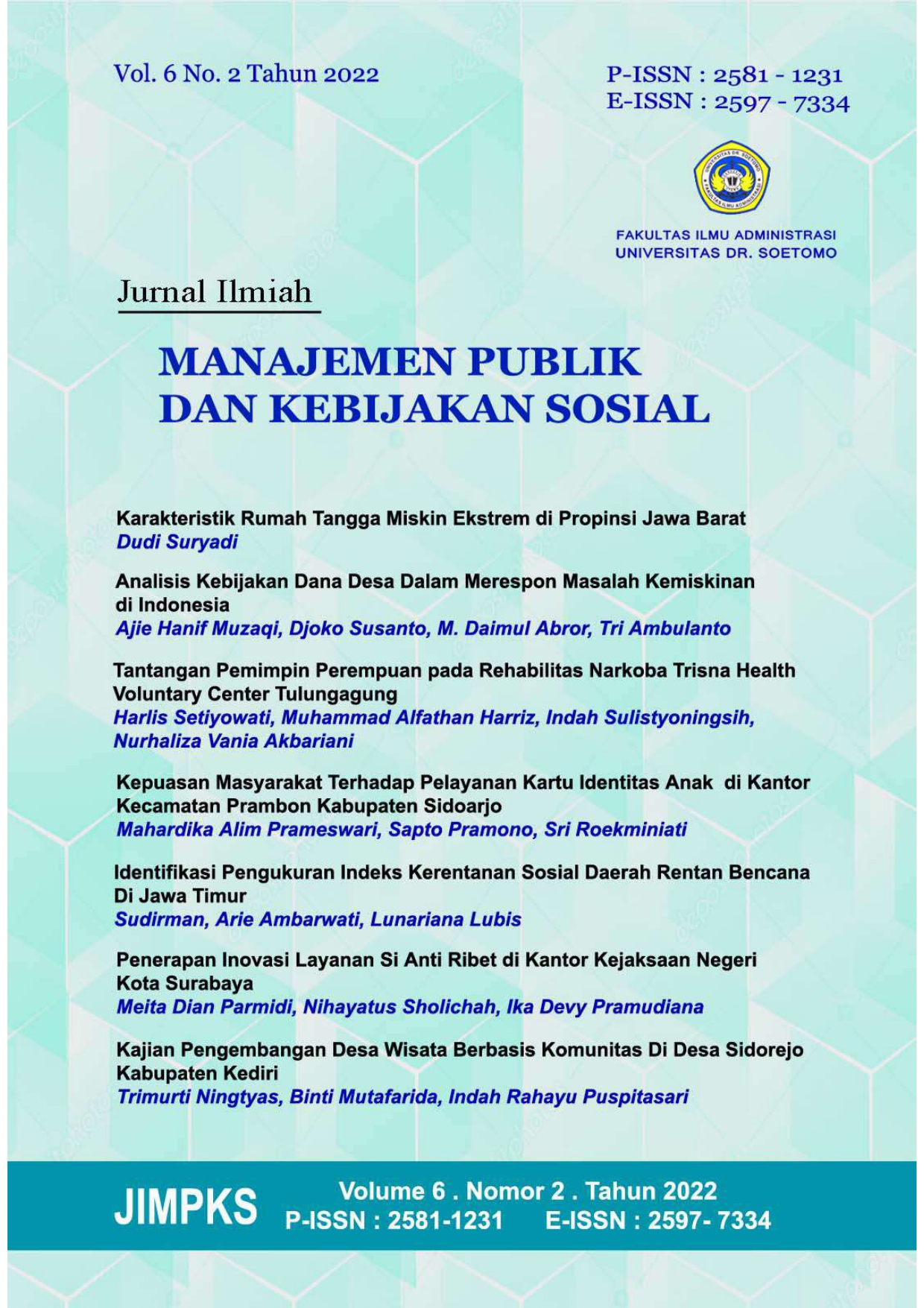Identifikasi Pengukuran Indeks Kerentanan Sosial Daerah Rentan Bencana Di Jawa Timur
 Abstrak views: 581
,
Abstrak views: 581
,
 PDF downloads: 1004
PDF downloads: 1004
Abstrak
Indonesia's geographical position and topography in the ring of fire are very at risk of experiencing natural disasters, including earthquakes, volcanic eruptions, tsunamis, floods, landslides, and others. Disasters will always have an impact on property and human losses, and often cause the destruction of a particular society. The demographics of the people of East Java which consist of many ethnic groups as a consequence of the second largest province with a high rate of economic growth in Indonesia allows social conflicts to occur which can also cause disasters and material and non-material losses. The aim of this research is to observe and analyze the factors measuring the value of the social vulnerability index in disaster-prone areas in East Java. Research on the Measurement Factors of the Social Vulnerability Index of Disaster Vulnerable Areas in East Java uses descriptive quantitative statistical data analysis methods or techniques, namely factor analysis and scoring analysis. The research findings obtained 4 dominant factors in determining level of regional social vulnerability in 8 regencies/cities. The dominant factors consist of Factor I: composition of household special needs and low education (disability, age comparison, elementary education), factor II: social status (occupation status, welfare level, marital status), factor III: economic status and Junior high school education (income, junior high school education and factor IV: Higher education level (college and high school education) These four dominant factors are factors that will later be used in calculating the level of regional social vulnerability in 8 regencies/cities in East Java Province
Referensi
Arief, M., & Pigawati, B. (2015). Kajian Kerentanan Di Kawasan Permukinan Rawan Bencana Kecamatan Semarang Barat, Kota Semarang. Teknik PWK (Perencanaan Wilayah Kota), 4(2), 332–344. https://doi.org/10.14710/TPWK.2015.8608
Arifin, Z. (2010). Pola Spasial Kerentanan Bencana Alam (Studi Kasus Kabupaten Cianjur) (p. 21). Universitas Indonesia.
Carreño, M. L., Cardona, O. D., & Barbat, A. H. (2007). A disaster risk management performance index. Natural Hazards, 41(1), 1–20. https://doi.org/10.1007/s11069-006-9008-y
Chen, W., Cutter, S. L., Emrich, C. T., & Shi, P. (2013). Measuring social vulnerability to natural hazards in the Yangtze River Delta region, China. International Journal of Disaster Risk Science, 4(4), 169–181. https://doi.org/10.1007/s13753-013-0018-6
Comfort, L. K. (2005). Risk, security, and disaster management. Annual Review of Political Science, 8, 335–356. https://doi.org/10.1146/annurev.polisci.8.081404.075608
Cutter, S. L., Boruff, B. J., & Shirley, W. L. (2003). Social Vulnerability to Environmental Hazards*. Social Science Quarterly, 84(2), 242–261. https://doi.org/10.1111/1540-6237.8402002
Flanagan, B. E., Gregory, E. W., Hallisey, E. J., Heitgerd, J. L., & Lewis, B. (2011). A Social Vulnerability Index for Disaster Management. Journal of Homeland Security and Emergency Management, 8(1). https://doi.org/10.2202/1547-7355.1792
Hizbaron, D., Hadmoko, D., Samodra, G., Dalimunthe, S., & Sartohadi, dan J. (2010). Tinjauan Kerentanan, Risiko dan Zonasi Rawan Bahaya Rockfall di Kulonprogo, Yogyakarta. Forum Geografi, 24(2), 119–136. https://doi.org/10.23917/FORGEO.V24I2.5021
Houston, D., Werritty, A., Ball, T., & Black, A. (2021). Environmental vulnerability and resilience: Social differentiation in short- and long-term flood impacts. Transactions of the Institute of British Geographers, 46(1), 102–119. https://doi.org/10.1111/TRAN.12408
Janssen, M., Lee, J., Bharosa, N., & Cresswell, A. (2010). Advances in multi-agency disaster management: Key elements in disaster research. Information Systems Frontiers, 12(1), 1–7. https://doi.org/10.1007/s10796-009-9176-x
Larasati, D. A., Bambang, D., Jurusan, H., Geografi, P., Sosial, I., & Hukum, D. (2016). Kajian Kelembagaan dan Regulasi Penanggulangan Bencana di Kabupaten Bojonegoro. Prosiding Seminar Nasional Geografi UMS. http://publikasiilmiah.ums.ac.id/handle/11617/8222
Lei, Y., Wang, J., Yue, Y., Zhou, H., & Yin, W. (2014). Rethinking the relationships of vulnerability, resilience, and adaptation from a disaster risk perspective. Natural Hazards, 70(1), 609–627. https://doi.org/10.1007/s11069-013-0831-7
Lin, W. Y., & Hung, C. T. (2016). Applying spatial clustering analysis to a township-level social vulnerability assessment in Taiwan. Geomatics, Natural Hazards and Risk, 7(5), 1659–1676. https://doi.org/10.1080/19475705.2015.1084542
Radtke, K., Mann, H., Weller, D., Kirch, L., & Prütz, R. (2018). The WorldRiskReport 2018. In WorldRiskReport 2018: Child Protection & Children’s Rights.
Singh, S. R., Eghdami, M. R., & Singh, S. (2014). The Concept of Social Vulnerability : A Review from Disasters Perspectives. International Journal of Interdisciplinary and Multidisciplinary Studies, 1(6), 71–82. http://www.ijims.com
##submission.copyrightStatement##
##submission.license.cc.by-sa4.footer##
Authors who publish with JIMPKS: Jurnal Ilmiah Manajemen Publik dan Kebijakan Sosial agree to the following terms:
-
Authors retain copyright and grant the journal right of first publication with the work simultaneously licensed under a Creative Commons Attribution License (CC BY-SA 4.0) that allows others to share the work with an acknowledgment of the work's authorship and initial publication in this journal.
-
Authors are able to enter into separate, additional contractual arrangements for the non-exclusive distribution of the journal's published version of the work (e.g., post it to an institutional repository or publish it in a book), with an acknowledgment of its initial publication in this journal.
-
Authors are permitted and encouraged to post their work online (e.g., in institutional repositories or on their website) prior to and during the submission process, as it can lead to productive exchanges, as well as earlier and greater citation of published work.










